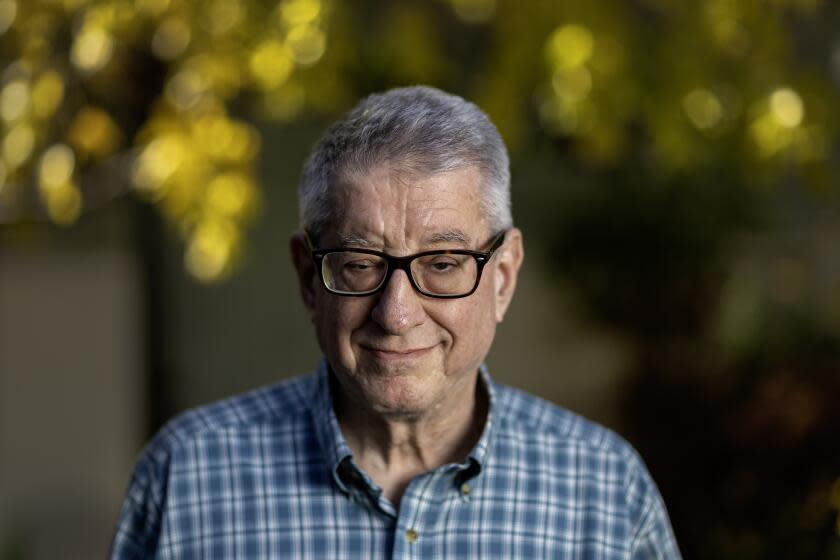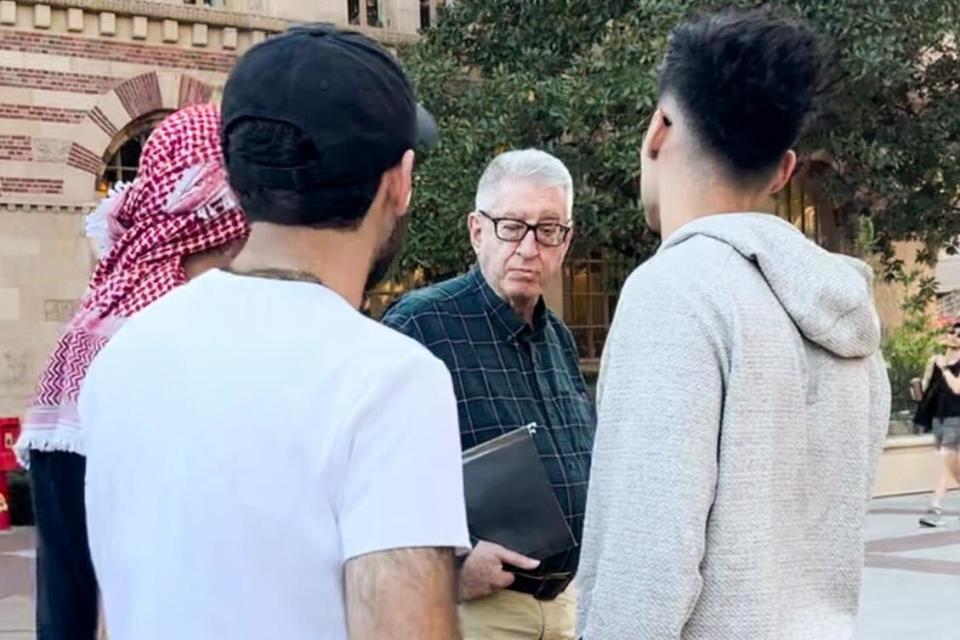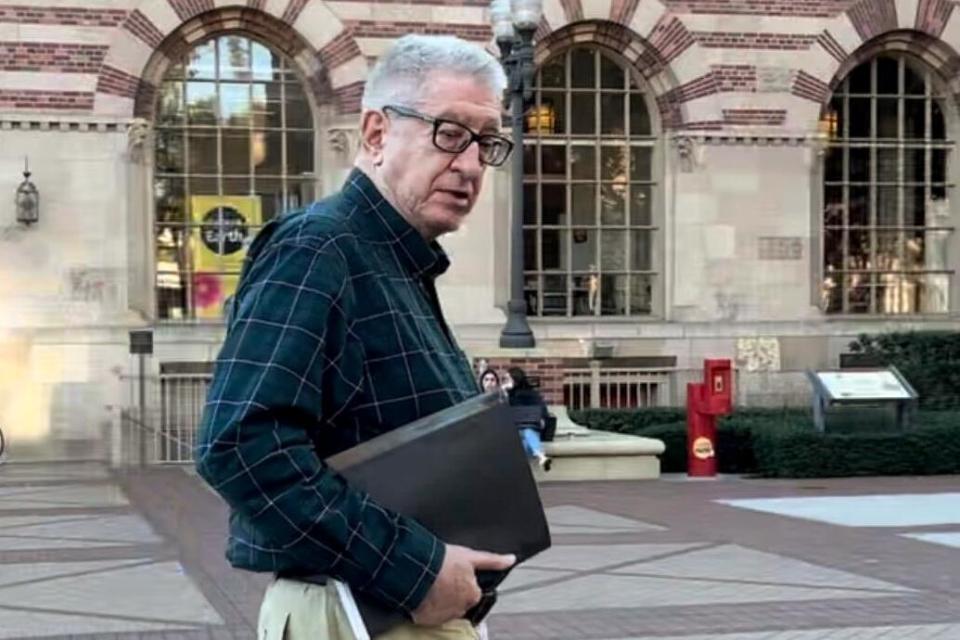A Jewish professor at USC confronted pro-Palestinian students. He's now barred from campus

Until recently, USC professor John Strauss was known mostly for his research on the economics of developing countries, with decades of fieldwork in Indonesia and China.
That changed Nov. 9, when Strauss stopped before students staging a walkout and protest calling for a cease-fire in the Gaza Strip and holding a memorial to thousands of Palestinian civilians killed in the Israel-Hamas war.
The economics professor’s interactions with students that day ended with the 72-year-old Strauss, who is Jewish, declaring: “Hamas are murderers. That’s all they are. Every one should be killed, and I hope they all are killed.”
Students captured those remarks on their cellphones, almost instantly seeming to recognize a viral moment. “Can you say that for the camera?” one pressed.

Within hours, Strauss’ comments were posted online, shared and reshared on X, Instagram, Facebook and TikTok.
As his remarks raced across the internet, his condemnation of Hamas was often excised, leaving only his “hope” for “all” to be killed. Captions and comments online framed his demand for “every one” to be killed in myriad, at times deceptive, ways. One Instagram post shared to millions of users claimed falsely that Strauss told the students, “[I] hope you get killed....”
Within a day, an associate dean told Strauss that he was on paid administrative leave, barred from campus, and that he would no longer teach his undergraduates this semester.
Within the week, a petition demanding that USC fire Strauss for his “racist, xenophobic behavior” and comments that “promote and incite violence” had collected more than 6,500 signatures.
Meanwhile, more than 9,000 signed a counter-petition decrying USC’s treatment of Strauss as “unjust,” saying he was the victim of online misinformation, and demanding that the university reinstate him.
Hussam Ayloush, executive director of the Council on American-Islamic Relations in Los Angeles, called for USC to launch an investigation into Strauss and to take actions to protect “Muslim, Palestinian and Arab students as well as any others who are targeted by hate and bigotry.”
Jonathan Friedman, director of free expression at PEN America, criticized USC for “a shocking overreaction,” adding in a statement, “What USC has done runs counter to the university’s obligation to foster dialogue and debate.”
By now, millions have viewed portions of Strauss’ remarks, and his statements — and USC’s response — have become a Rorschach test for a war raging 7,500 miles away.
With its political, ethnic, generational and religious fault lines, the incident has reignited intractable debates over campus censorship, academic freedom and student safety. Nearly every student who spoke to The Times for this article would do so only on condition of anonymity, citing a fear of online harassment.
But at a fundamental level, the episode is also a debate over what exactly transpired.
::
On that Thursday in early November, Strauss walked across USC’s brick-paved campus to teach an undergraduate course on the economics of sub-Saharan Africa.
He saw a large crowd by the university’s landmark statue, Tommy Trojan. At first he thought it was a demonstration for grad students who are negotiating their first union contract and threatening a strike.
He got closer and said he saw “that it was a big Palestinian demonstration.” He told The Times that he heard slogans such as “Destroy Israel” and calls for the U.S. to revoke funding for Israel. (Students dispute that "destroy Israel" was ever uttered at the demonstration.)
“That’s what I heard and I got angry,” said Strauss, who has worked at USC since 2004 and has tenure. “I am Jewish and very pro-Israel, so I shouted, ‘Israel forever. Hamas are murderers.’”
The demonstration was part of a national “Shut It Down for Palestine” action and included a student walkout from class, a march through campus and a rally where some students chanted, “From the river to the sea, Palestine will be free,” a phrase that is viewed as either a call for Palestinians to have equality or a call for the destruction of Israel, depending on the listener.
Near a busy campus corridor, the event also included a memorial to Palestinians killed in Gaza since Oct. 7, a death toll that was then about 10,000 and that has since grown to more than 13,000, according to the Hamas-run Health Ministry. Partly enclosed by a fence, the memorial featured four long rolls of paper, at least 18 inches wide, unfurled several feet across the ground. On the paper were printed thousands of names.
Students said that when Strauss came to the demonstration, he stepped on the paper. One student said he was “desecrating the names.”
“All I did was walk through the crowd,” Strauss said, insisting he never saw the list of names but spotted the memorial later in the day after the crowd had dissipated. He acknowledged that he “might well have accidentally walked on” the list but said it was “completely unintentional.”
No one appears to have recorded the first interaction, but students say his presence caused a stir.
When Daphne, a USC student who asked to be identified only by her first name, came to help at the memorial and stand by a table for the event, she said she was told about an older man who seemed to be a professor and had shouted something like, “Long live Israel.”
“At that point, we didn’t know who he was,” she recalled.
::
Strauss’ undergraduate class ended around 3 p.m. and he planned to return to his office, on the western edge of campus, by passing by the Tommy Trojan statue and pro-Palestinian demonstration.
By that point, a cluster of Jewish students had begun to stand about 50 feet from the demonstration.
One of the students, who described herself as Jewish and a Zionist and also spoke on condition of anonymity, said she had seen the rally and memorial for Palestinians after her class let out. She said that although she felt “horrible for the innocent lives lost on both sides,” she was also upset that the event made “no mention of Hamas, a terrorist organization.”
She recalled seeing a fellow Jewish student nearby. “We just decided to stand and hold our flag. We weren’t saying anything,” she said.
In the center of campus, the two Jewish students held their mini Israeli flags aloft and were eventually joined by a rabbi and other Jewish peers wearing kippahs. Fifty feet away, Daphne and her peers watched over the memorial for slain Palestinians. A metal fence separated the two groups.
Each accused the other side of taunts and “harassment.”
Just after 3 p.m., Strauss walked by after leaving his class.
Among the Jewish students, he was greeted warmly.
Strauss continued, rounding the corner toward USC’s bookstore when witnesses say at least one student yelled out, “Professor Strauss, shame on you.”
Clad in cargo pants and a plaid-green dress shirt, he said he bellowed, “No, shame on you.”
Then the cameras started rolling again.

“You people are ignorant, really ignorant,” Strauss said, holding a file of papers in one hand and a bottle of water in the other.
A student in a gray Lululemon waffle-knit hoodie and black pants is heard telling Strauss that the event was to “pay respects” to those killed. A classmate wearing a red kaffiyeh wrapped around his head rushed over and inserted himself between the professor and the students.
That was the moment when Strauss uttered the words that precipitated the uproar: Hamas are murderers. That’s all they are. Every one should be killed, and I hope they all are killed.
“I got that on video. Thank you!” a student says.
::
Strauss drove home and when he checked his email later that evening, he saw messages from Jewish students expressing support and realized that an Instagram page, Trojans for Palestine, had posted some of the video.
Strauss said that video was “heavily doctored.”
Daphne, who made one of the two videos circulating online, denied the recording was edited. “I do not possess the ability to doctor a video like that. And also we have a second video that matches so, like, there’s no way on God’s green Earth that I would have been able to doctor that video.”
To Strauss and his supporters, “doctored” means edited or clipped in a deceptive way. The Times could find no evidence that his voice had been altered or his words substantively changed in the video.
But as the clip circulated online, it was at times trimmed to a few seconds of Strauss uttering, “Every one should be killed.”
The captions and superimposed text in social media posts could be minimal, misleading or wrong.
“This zionist econ professor purposefully stepped on the list of martyrs before our march and came by again after & said ‘everyone should be killed,’” a student group posted on Instagram.
Another post on Instagram, shared by @CravingPalestine and activist Shaun King, among others, said Strauss “threatened these students ‘hope you get killed and I hope they all are (*Gaza)” during a campus rally for Gaza.” That post has been viewed more than 3.2 million times.
At one point, the group Trojans for Palestine clarified on Instagram that Strauss “did not say he wanted Palestinians to be killed, but Hamas,” according to screenshots of the post.
Then, the group appeared to walk it back: “With his hateful rhetoric, you can draw your own conclusion about whether or not he wished death upon just Hamas or civilians as well.”
Within hours of Strauss’ recorded comments, USC’s Muslim Student Union issued a statement saying that Strauss was “repeatedly calling for the murder of the entirety of Palestine” and expressing “a desire for the death of those supporting Palestine.”
“Such remarks are not only beyond the boundaries of academic discourse, but also dangerously incite violence and contribute to a hostile campus atmosphere,” the Muslim Student Union declared in its statement, which called for USC administrators to “ensure a safe space for students to express themselves.” It listed the email addresses of USC’s president, provost and other officials.
Strauss said his rhetorical target was Hamas.
“The allegation was that I said, ‘Kill all Palestinians.’ I never said that and I never would say that. I said, ‘Kill all Hamas.’ That’s quite different,” Strauss asserted.
::
Strauss learned about 24 hours later, on Nov. 10, that USC’s provost was placing him on paid administrative leave. He said he was told by a university dean that he could continue to teach graduate students via Zoom, but he would not teach undergraduates for the rest of the semester.
The provost told Strauss four days later that he was the subject of multiple complaints to USC’s equity, diversity and Title IX office and that he would continue to be barred from campus while complaints were investigated, according to a letter from the provost obtained by The Times.
In the meantime, Strauss was deluged with hateful emails, prompting USC to have a team review the messages for security threats.
The Academic Freedom Alliance provided legal counsel to Strauss and sent a letter to USC’s leaders on his behalf dismissing the notion that it was he who posed a threat to anyone on campus.
“The university becomes the instrument of a heckler’s veto when it punishes a member of the faculty when other members of the campus community or of the general public react vociferously enough to a professor’s lawful speech,” the alliance wrote.
About that time, USC lifted some of its measures against Strauss and allowed him to resume teaching undergraduates via Zoom. Still, the university kept in place his ban from campus.
A USC spokesperson declined to comment on the specifics of Strauss’ case. Asked about USC dropping its prohibition of Strauss teaching undergraduates, a spokesperson said in a statement, “The university is always willing to change its approach as it receives and considers more information; our north star is protecting the safety of our community.”
Strauss is being helped by fellow Jewish faculty and a network of students and alumni. Among them is Daisy Kahn, an alumna based in New York who said she became alarmed by posts online, including a slew of negative reviews on the Rate My Professors site.
“The relentless misinformation campaign has unfairly tarnished professor Strauss’ reputation but has also fueled division,” Kahn said.
Strauss wants USC to allow him back on campus and to issue “a factual statement of what I did not say.”
Asked whether he had any regrets, Strauss told a reporter, “No. I don’t. I did nothing wrong, and I’d probably do it the same way.”
This story originally appeared in Los Angeles Times.

